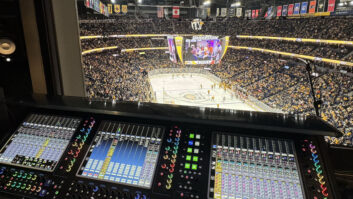Sound Innovations: A Manufacturer’s View
Universal Appeal, International Design
Inter-M IMX-824 SR Console
by YU Miya-zaki
Editor’s Note: The Inter-M console series originally released under the name “Kensington,” has been rebranded the IMX-824. The IMX-8 series now includes the IMX-832 and IMX-840 32- and 40- channel versions of the desk. This Sound Innovations article originally ran in Pro Sound News in October of 2005.
In Korea, Inter-M has been the market leader in pro audio and commercial sound products for more than 20 years. In the past few years, customers around the world have become more familiar with the brand name, performance and quality of our products. From that experience, we saw the need to enhance the product offerings by developing a range of analog consoles that could be used for both installed systems as well as live sound systems.
Over the past years, the number of manufacturers of mixing consoles has been shrinking, so customers have been facing a lack of choice. We knew that we couldn’t compromise quality and performance for our flagship. The challenge was to achieve our aims at an acceptable price point.
For the IMX-824’s control surface, we focused on offering an intelligent combination of some of the more important functions now accepted as normal on higher priced consoles. Ultra high performance mic preamps, swept high pass filter, LCR panning, precision metering on all channels, mute groups, and dual purpose (FOH and Monitor) outputs with fader flip, have been included. Although more features could have been added, it was considered important to maintain a clear logical layout, which could be used without confusion by even the inexperienced volunteer operators often called to duty in the house of worship market. And while it may sound strange, the reality is that most users that want to “try out” a new console do so by moving the faders. So we chose to use a very high quality Japanese fader, not just for the electrical characteristics, but also for the “feel” of the fader operation.
Mechanical construction and serviceability are equally important in what is a very conservative industry. IMX-824 is constructed with individual channel and output PCBs. Although more expensive to produce than the “all on one PCB and front panel” method currently used by most competitive products, the performance of this traditional method is definitely superior. Eight individual channel PCBs are mounted per module, and each module can be easily removed from the top. There is no need to invert the console and remove the bottom panels for servicing, because this is all but impossible in situ. For stability and strength, and good “feel”, all the potentiometers are fixed to the front panel.
However, some aspects of the design are not immediately obvious to the user, and although often ignored in other products because they don’t show up on the spec sheet, are vitally important in ensuring that the product works in a “real world” environment. Great care has been taken to ensure that there is adequate immunity to RF interference and general compliance with European EMC legislation. Additionally, as per the new AES 48-2005 standard, interfaces all comply with good “pin 1” grounding practice for ease of installation/integration into a system.
The core international design team was myself and, providing the British Heritage, David Dearden from Audient who acted as consultant to the project. Between us, we finalized all the system and circuit designs. The mechanical design and all PCB artworks were done in-house by Inter-M’s engineering staff. The feature set was the result of feedback from many potential users and consultants.
Dearden started his career as a studio engineer in 1968, and went on to work for MCI and Soundcraft. In 1980, together with Gareth Davies, he was co-founder of DDA, a well-known and well-respected manufacturer of mixing consoles in its day. He was responsible for most of their products, and also for the Midas XL200 console. DDA later became part of the Klark Teknik Group, which was subsequently acquired by the Mark 4 Audio Group. In 1997, Dearden and Davies started a new company named Audient, where he is technical director. He poured ideas into the IMX-824 based on his experience of mixing console use and design into the project to specify the system and circuit structure.
After spending a few years as a part-time mixing engineer at small SR company, I started my own career as a designer for Japanese manufacturer, Tamura, 15 years ago. Tamura mainly makes mixing consoles and audio equipment for broadcast stations.
Due to the individual requirements and technical strictness of Japanese broadcast stations, all the consoles I designed were custom-made. I had wide latitude in the consoles I designed: traditional analog, digitally controlled analog, and all-digital consoles. I’m proud that my biggest system, which is a 128-mic input, full 5.1 surround panning, 104 mix bus, digitally controlled and fully assignable analog console, is still working in NHK (the Japanese national broadcasting organization) eight years after its installation.
After my last Tamura project (a small digital mixer and tube-type mic preamps with AD/DA), I then moved from Japan to South Korea, and joined Inter-M to take part in their new SR project late in 2004.
With regard to circuitry, designing analog mixing consoles is not a serious challenge, since today we are able to take advantage of many advancements in circuit design that have been developed over the past 25 years or so. However, the “human engineering” aspects of the design are more complicated: how do we design a control surface, which will make people feel comfortable in real-world applications?
I believe there are two types of mixing engineers: the “techie guru” and the “simple is best.” The techie guru is concerned with whether the “Q” of his lo-mid EQ control is “1.45” or “1.33” at 800 Hz, for example. He feels he needs a vast array of switches, controls and potentiometers to make sound he likes, even if he never uses most of these items in the real world.
Alternately, the “simple is best” engineer dislikes complex Scene-Recall systems or unfamiliar blinking lights and switches that will only distract him during a show. This engineer loves high-quality audio circuitry, simple functionality, straight signal paths and ease of operation.
As a result of these varying desires, we spent a lot of time in the design of the IMX-824 to determine the control surface that would appeal to all mixing engineers, and we will continue to do our best to satisfy all users in future console projects.
High-quality pro audio is a challenging field for design engineers. In video, if you ask 100 people about whether or not a certain monitor has a good image, you probably will get much the same opinion from them all. However, with pro audio, you’ll likely have a number of opinions equal to the number of listeners when asking about the sound quality of professional amplifiers, mixing consoles, loudspeaker systems and so on.
Frankly speaking, most pro audio design engineers know how to “color” the sound quality of a product if they wish, and many of them know how to keep sound extremely clean, as well. We chose to make sure that the new IMX-824 console sounds clean and that the operation is easy and intuitive for the operator, since that is probably the very best choice for our new entry into the mixer market.







